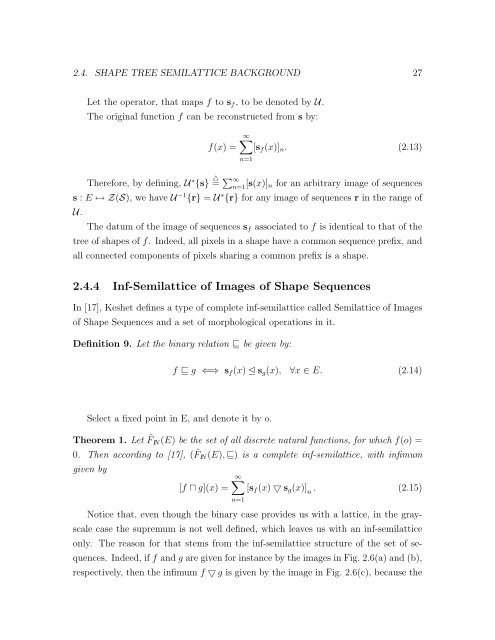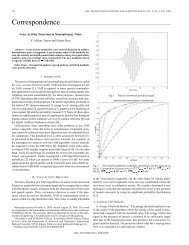Thesis (PDF) - Signal & Image Processing Lab
Thesis (PDF) - Signal & Image Processing Lab
Thesis (PDF) - Signal & Image Processing Lab
You also want an ePaper? Increase the reach of your titles
YUMPU automatically turns print PDFs into web optimized ePapers that Google loves.
2.4. SHAPE TREE SEMILATTICE BACKGROUND 27<br />
Let the operator, that maps f to sf, to be denoted by U.<br />
The original function f can be reconstructed from s by:<br />
f(x) =<br />
∞�<br />
[sf(x)]n. (2.13)<br />
n=1<br />
Therefore, by defining, U ∗ {s} △ = � ∞<br />
n=1 [s(x)]n for an arbitrary image of sequences<br />
s : E ↦→ Z(S), we have U −1 {r} = U ∗ {r} for any image of sequences r in the range of<br />
U.<br />
The datum of the image of sequences sf associated to f is identical to that of the<br />
tree of shapes of f. Indeed, all pixels in a shape have a common sequence prefix, and<br />
all connected components of pixels sharing a common prefix is a shape.<br />
2.4.4 Inf-Semilattice of <strong>Image</strong>s of Shape Sequences<br />
In [17], Keshet defines a type of complete inf-semilattice called Semilattice of <strong>Image</strong>s<br />
of Shape Sequences and a set of morphological operations in it.<br />
Definition 9. Let the binary relation ⊑ be given by:<br />
f ⊑ g ⇐⇒ sf(x) � sg(x), ∀x ∈ E. (2.14)<br />
Select a fixed point in E, and denote it by o.<br />
Theorem 1. Let ˜ FIN(E) be the set of all discrete natural functions, for which f(o) =<br />
0. Then according to [17], ( ˜ FIN(E), ⊑) is a complete inf-semilattice, with infimum<br />
given by<br />
[f ⊓ g](x) =<br />
∞�<br />
[sf(x) ▽ sg(x)] n . (2.15)<br />
n=1<br />
Notice that, even though the binary case provides us with a lattice, in the gray-<br />
scale case the supremum is not well defined, which leaves us with an inf-semilattice<br />
only. The reason for that stems from the inf-semilattice structure of the set of se-<br />
quences. Indeed, if f and g are given for instance by the images in Fig. 2.6(a) and (b),<br />
respectively, then the infimum f ▽ g is given by the image in Fig. 2.6(c), because the
















